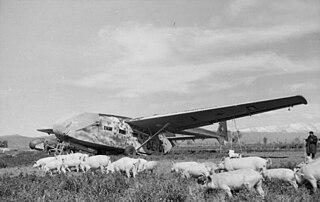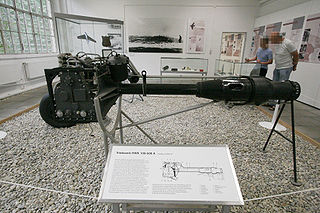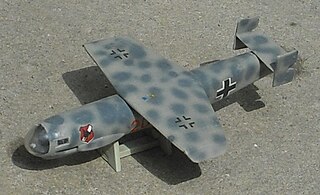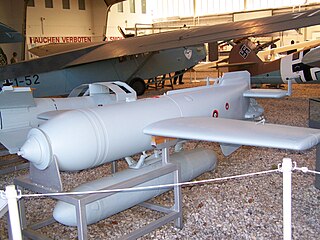Related Research Articles

The Messerschmitt Me 163 Komet is a rocket-powered interceptor aircraft primarily designed and produced by the German aircraft manufacturer Messerschmitt. It is the only operational rocket-powered fighter aircraft in history as well as the first piloted aircraft of any type to exceed 1,000 kilometres per hour (620 mph) in level flight.

JATO is a type of assisted take-off for helping overloaded aircraft into the air by providing additional thrust in the form of small rockets. The term JATO is used interchangeably with the term RATO, for rocket-assisted take-off.

A hypergolic propellant is a rocket propellant combination used in a rocket engine, whose components spontaneously ignite when they come into contact with each other.
T-Stoff ([teː ʃtɔf]; 'substance T') was a stabilised high test peroxide used in Germany during World War II. T-Stoff was specified to contain 80% (occasionally 85%) hydrogen peroxide (H2O2), remainder water, with traces (<0.1%) of stabilisers. Stabilisers used included 0.0025% phosphoric acid, a mixture of phosphoric acid, sodium phosphate and 8-oxyquinoline, and sodium stannate.

Hellmuth Walter was a German engineer who pioneered research into rocket engines and gas turbines. His most noteworthy contributions were rocket motors for the Messerschmitt Me 163 and Bachem Ba 349 interceptor aircraft, so-called Starthilfe jettisonable rocket propulsion units used for a variety of Luftwaffe aircraft during World War II, and a revolutionary new propulsion system for submarines known as air-independent propulsion (AIP).

The Messerschmitt Me 263 Scholle (plaice) was a rocket-powered fighter aircraft developed from the Me 163 Komet towards the end of World War II. Three prototypes were built but never flown under their own power as the rapidly deteriorating military situation in Germany prevented the completion of the test program.

The DFS 194 was a rocket-powered aircraft designed by Alexander Lippisch at the Deutsche Forschungsanstalt für Segelflug.

The Mitsubishi J8M Shūsui is a Japanese World War II rocket-powered interceptor aircraft closely based on the German Messerschmitt Me 163 Komet. Built as a joint project for both the Navy and the Army Air Services, it was designated J8M (Navy) and Ki-200 (Army).

The DFS 346 was a German rocket-powered swept-wing aircraft which began development during World War II in Germany. It was designed by Felix Kracht at the Deutsche Forschungsanstalt für Segelflug (DFS), the "German Institute for Sailplane Flight". A prototype was constructed but did not reach completion before the end of the war. It was taken to the Soviet Union where it was completed, tested and flown.
Z-Stoff was a name for calcium permanganate or sodium permanganate mixed in water. It was normally used as a catalyst for T-Stoff in military rocket programs by Nazi Germany during World War II.

The Gotha Go 242 was a transport glider used by the Luftwaffe during World War II. It was an upgrade over the DFS 230 in both cargo/troop capacity and flight characteristics. It saw limited combat action. There were multiple glider variants, and it became the basis for a transport aircraft, the: Gotha Go 244.
A steam rocket is a thermal rocket that uses water held in a pressure vessel at a high temperature, such that its saturated vapor pressure is significantly greater than ambient pressure. The water is allowed to escape as steam through a rocket nozzle to produce thrust.

The Walter HWK 109-509 was a German liquid-fuel bipropellant rocket engine that powered the Messerschmitt Me 163 Komet and Bachem Ba 349 aircraft. It was produced by Hellmuth Walter Kommanditgesellschaft (HWK) commencing in 1943, with licensed production by the Heinkel firm's facilities in Jenbach, Austria.

The Arado E.381 was a proposed parasite fighter aircraft. Conceived by Arado Flugzeugwerke in December 1944 for Germany's Luftwaffe during World War II, the E.381 was to have been carried aloft by and launched from an Arado Ar 234 "mother" aircraft. It would then have activated its rocket engine, which would have propelled it to attack Allied bombers. Development was cancelled due to lack of funds and official support.

The Heinkel P.1077 was a single seat interceptor design developed for the Luftwaffe by Heinkel under the Emergency Fighter Program during the last year of the Third Reich. This rocket-powered project was originally known as He P.1068, but that name was later used for a Heinkel design project for a turbojet-powered medium bomber.
The BMW 109-718 was a liquid-fuelled rocket engine developed by BMW at their Bruckmühl facility, in Germany during the Second World War.

The Walter HWK 109-500 was a liquid-fuelled rocket engine developed by Walter in Germany during the Second World War.

The HWK 109-507 was a liquid-propellant rocket engine developed by Germany during World War II. It was used to propel the Hs 293 anti-ship guided missile.
References
- ↑ Zaloga, Steven (2008). German V-Weapon Sites 1943-45. Oxford: Osprey Publishing. p. 17. ISBN 9781846032479.